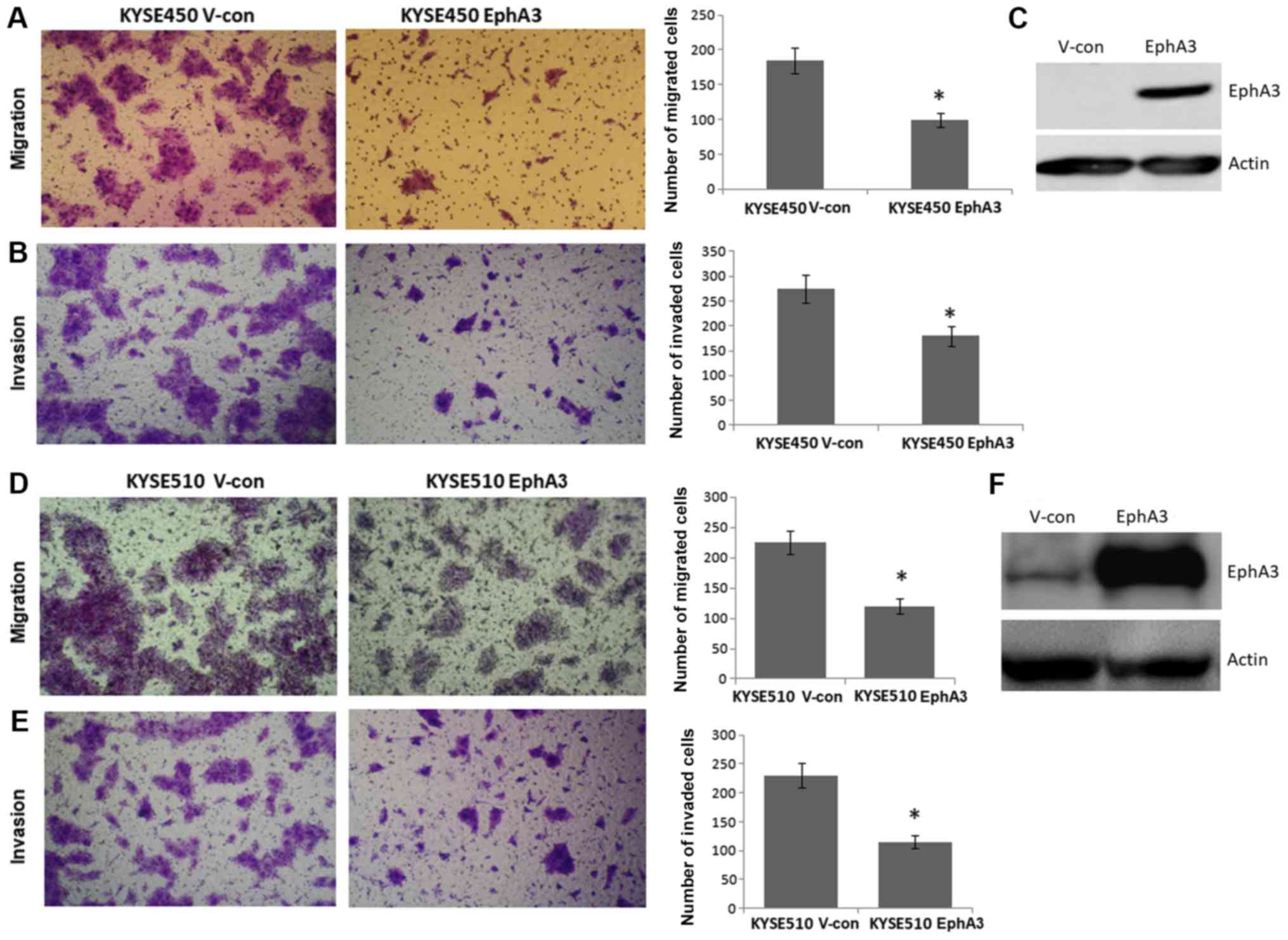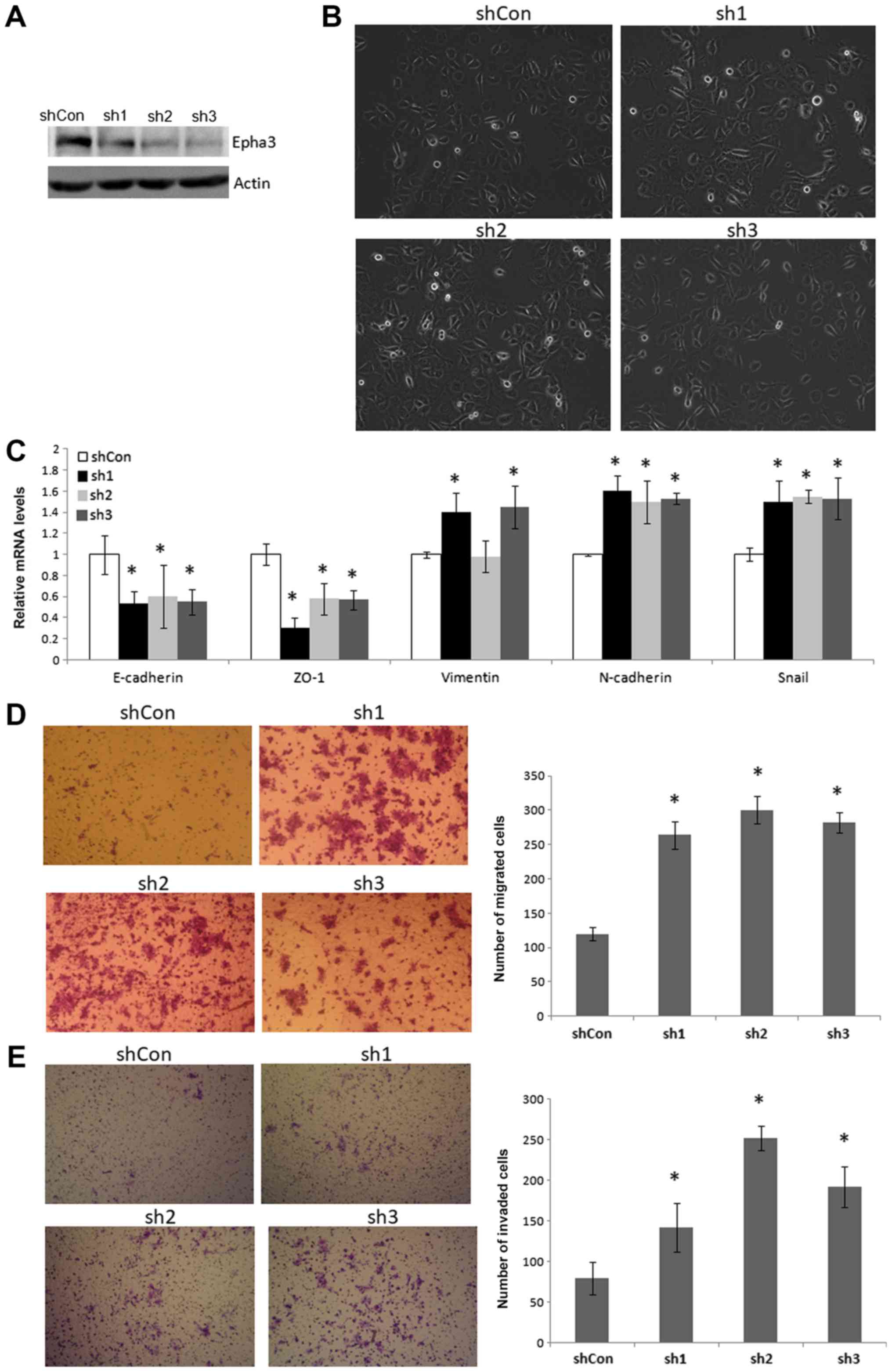|
1
|
Liu Y, Xiong Z, Beasley A, D'Amico T and
Chen XL: Personalized and targeted therapy of esophageal squamous
cell carcinoma: An update. Ann N Y Acad Sci. 1381:66–73. 2016.
View Article : Google Scholar : PubMed/NCBI
|
|
2
|
Ferlay J, Shin HR, Bray F, Forman D,
Mathers C and Parkin DM: Estimates of worldwide burden of cancer in
2008: GLOBOCAN 2008. Int J Cancer. 127:2893–2917. 2010. View Article : Google Scholar
|
|
3
|
Baba Y, Watanabe M, Yoshida N and Baba H:
Neoadjuvant treatment for esophageal squamous cell carcinoma. World
J Gastrointest Oncol. 6:121–128. 2014. View Article : Google Scholar : PubMed/NCBI
|
|
4
|
Pennathur A, Gibson MK, Jobe BA and
Luketich JD: Oesophageal carcinoma. Lancet. 381:400–412. 2013.
View Article : Google Scholar : PubMed/NCBI
|
|
5
|
Pasquale EB: Eph receptors and ephrins in
cancer: Bidirectional signalling and beyond. Nat Rev Cancer.
10:165–180. 2010. View
Article : Google Scholar : PubMed/NCBI
|
|
6
|
Zelinski DP, Zantek ND, Stewart JC,
Irizarry AR and Kinch MS: EphA2 overexpression causes tumorigenesis
of mammary epithelial cells. Cancer Res. 61:2301–2306.
2001.PubMed/NCBI
|
|
7
|
Easty DJ, Herlyn M and Bennett DC:
Abnormal protein tyrosine kinase gene expression during melanoma
progression and metastasis. Int J Cancer. 60:129–136. 1995.
View Article : Google Scholar : PubMed/NCBI
|
|
8
|
Herath NI, Spanevello MD, Doecke JD, Smith
FM, Pouponnot C and Boyd AW: Complex expression patterns of Eph
receptor tyrosine kinases and their ephrin ligands in colorectal
carcinogenesis. Eur J Cancer. 48:753–762. 2012. View Article : Google Scholar
|
|
9
|
Nieto MA, Huang RY, Jackson RA and Thiery
JP: Emt: 2016. Cell. 166:21–45. 2016. View Article : Google Scholar : PubMed/NCBI
|
|
10
|
Wicks IP, Wilkinson D, Salvaris E and Boyd
AW: Molecular cloning of HEK, the gene encoding a receptor tyrosine
kinase expressed by human lymphoid tumor cell lines. Proc Natl Acad
Sci USA. 89:1611–1615. 1992. View Article : Google Scholar : PubMed/NCBI
|
|
11
|
Gale NW, Holland SJ, Valenzuela DM,
Flenniken A, Pan L, Ryan TE, Henkemeyer M, Strebhardt K, Hirai H,
Wilkinson DG, et al: Eph receptors and ligands comprise two major
specificity subclasses and are reciprocally compartmentalized
during embryogenesis. Neuron. 17:9–19. 1996. View Article : Google Scholar : PubMed/NCBI
|
|
12
|
Stephen LJ, Fawkes AL, Verhoeve A, Lemke G
and Brown A: A critical role for the EphA3 receptor tyrosine kinase
in heart development. Dev Biol. 302:66–79. 2007. View Article : Google Scholar
|
|
13
|
Chiari R, Hames G, Stroobant V, Texier C,
Maillère B, Boon T and Coulie PG: Identification of a
tumor-specific shared antigen derived from an Eph receptor and
presented to CD4 T cells on HLA class II molecules. Cancer Res.
60:4855–4863. 2000.PubMed/NCBI
|
|
14
|
Dottori M, Down M, Hüttmann A, Fitzpatrick
DR and Boyd AW: Cloning and characterization of EphA3 (Hek) gene
promoter: DNA methylation regulates expression in hematopoietic
tumor cells. Blood. 94:2477–2486. 1999.PubMed/NCBI
|
|
15
|
Lawrenson I D, Wim mer-K lei ka mp SH, L
ock P, Schoenwaelder SM, Down M, Boyd AW, Alewood PF and Lackmann
M: Ephrin-A5 induces rounding, blebbing and de-adhesion of
EphA3-expressing 293T and melanoma cells by CrkII and Rho-mediated
signalling. J Cell Sci. 115:1059–1072. 2002.PubMed/NCBI
|
|
16
|
Xi HQ, Wu XS, Wei B and Chen L: Aberrant
expression of EphA3 in gastric carcinoma: Correlation with tumor
angiogenesis and survival. J Gastroenterol. 47:785–794. 2012.
View Article : Google Scholar : PubMed/NCBI
|
|
17
|
Davies H, Hunter C, Smith R, Stephens P,
Greenman C, Bignell G, Teague J, Butler A, Edkins S, Stevens C, et
al: Somatic mutations of the protein kinase gene family in human
lung cancer. Cancer Res. 65:7591–7595. 2005. View Article : Google Scholar : PubMed/NCBI
|
|
18
|
Stephens P, Edkins S, Davies H, Greenman
C, Cox C, Hunter C, Bignell G, Teague J, Smith R, Stevens C, et al:
A screen of the complete protein kinase gene family identifies
diverse patterns of somatic mutations in human breast cancer. Nat
Genet. 37:590–592. 2005. View
Article : Google Scholar : PubMed/NCBI
|
|
19
|
Wood LD, Calhoun ES, Silliman N, Ptak J,
Szabo S, Powell SM, Riggins GJ, Wang TL, Yan H, Gazdar A, et al:
Somatic mutations of GUCY2F, EPHA3, and NTRK3 in human cancers. Hum
Mutat. 27:1060–1061. 2006. View Article : Google Scholar : PubMed/NCBI
|
|
20
|
Brown J, Bothma H, Veale R and Willem P:
Genomic imbalances in esophageal carcinoma cell lines involve Wnt
pathway genes. World J Gastroenterol. 17:2909–2923. 2011.
View Article : Google Scholar : PubMed/NCBI
|
|
21
|
Chen J, Guo L, Peiffer DA, Zhou L, Chan
OT, Bibikova M, Wickham-Garcia E, Lu SH, Zhan Q, Wang-Rodriguez J,
et al: Genomic profiling of 766 cancer-related genes in archived
esophageal normal and carcinoma tissues. Int J Cancer.
122:2249–2254. 2008. View Article : Google Scholar : PubMed/NCBI
|
|
22
|
Li JZ, Chen X, Gong XL, Hu HY, Shi D, Lu
YM, Qiu L, Lu F, Hu ZL and Zhang JP: Identification of a functional
nuclear localization signal mediating nuclear import of the zinc
finger transcription factor ZNF24. PLoS One. 8:e799102013.
View Article : Google Scholar : PubMed/NCBI
|
|
23
|
Ren XD, Kiosses WB and Schwartz MA:
Regulation of the small GTP-binding protein Rho by cell adhesion
and the cytoskeleton. EMBO J. 18:578–585. 1999. View Article : Google Scholar : PubMed/NCBI
|
|
24
|
Li J, Chen X, Gong X, Liu Y, Feng H, Qiu
L, Hu Z and Zhang J: A transcript profiling approach reveals the
zinc finger transcription factor ZNF191 is a pleiotropic factor.
BMC Genomics. 10:2412009. View Article : Google Scholar : PubMed/NCBI
|
|
25
|
Livak KJ and Schmittgen TD: Analysis of
relative gene expression data using real-time quantitative PCR and
the 2(−Delta Delta C(T)) method. Methods. 25:402–408. 2001.
View Article : Google Scholar
|
|
26
|
Brennaman LH, Moss ML and Maness PF:
EphrinA/EphA-induced ectodomain shedding of neural cell adhesion
molecule regulates growth cone repulsion through ADAM10
metalloprotease. J Neurochem. 128:267–279. 2014. View Article : Google Scholar
|
|
27
|
Hu T, Shi G, Larose L, Rivera GM, Mayer BJ
and Zhou R: Regulation of process retraction and cell migration by
EphA3 is mediated by the adaptor protein Nck1. Biochemistry.
48:6369–6378. 2009. View Article : Google Scholar : PubMed/NCBI
|
|
28
|
Binns KL, Taylor PP, Sicheri F, Pawson T
and Holland SJ: Phosphorylation of tyrosine residues in the kinase
domain and juxtamembrane region regulates the biological and
catalytic activities of Eph receptors. Mol Cell Biol. 20:4791–4805.
2000. View Article : Google Scholar : PubMed/NCBI
|
|
29
|
Etienne-Manneville S and Hall A: Rho
GTPases in cell biology. Nature. 420:629–635. 2002. View Article : Google Scholar : PubMed/NCBI
|
|
30
|
Sahai E and Marshall CJ: RHO-GTPases and
cancer. Nat Rev Cancer. 2:133–142. 2002. View Article : Google Scholar
|
|
31
|
Wahl S, Barth H, Ciossek T, Aktories K and
Mueller BK: Ephrin-A5 induces collapse of growth cones by
activating Rho and Rho kinase. J Cell Biol. 149:263–270. 2000.
View Article : Google Scholar : PubMed/NCBI
|
|
32
|
Dodelet VC and Pasquale EB: Eph receptors
and ephrin ligands: Embryogenesis to tumorigenesis. Oncogene.
19:5614–5619. 2000. View Article : Google Scholar : PubMed/NCBI
|
|
33
|
Clevers H and Batlle E: EphB/EphrinB
receptors and Wnt signaling in colorectal cancer. Cancer Res.
66:2–5. 2006. View Article : Google Scholar : PubMed/NCBI
|
|
34
|
Surawska H, Ma PC and Salgia R: The role
of ephrins and Eph receptors in cancer. Cytokine Growth Factor Rev.
15:419–433. 2004. View Article : Google Scholar : PubMed/NCBI
|
|
35
|
Oricchio E, Nanjangud G, Wolfe AL, Schatz
JH, Mavrakis KJ, Jiang M, Liu X, Bruno J, Heguy A, Olshen AB, et
al: The Eph-receptor A7 is a soluble tumor suppressor for
follicular lymphoma. Cell. 147:554–564. 2011. View Article : Google Scholar : PubMed/NCBI
|
|
36
|
Hatano M, Eguchi J, Tatsumi T, Kuwashima
N, Dusak JE, Kinch MS, Pollack IF, Hamilton RL, Storkus WJ and
Okada H: EphA2 as a glioma-associated antigen: A novel target for
glioma vaccines. Neoplasia. 7:717–722. 2005. View Article : Google Scholar : PubMed/NCBI
|
|
37
|
Lee JW, Han HD, Shahzad MM, Kim SW,
Mangala LS, Nick AM, Lu C, Langley RR, Schmandt R, Kim HS, et al:
EphA2 immunoconjugate as molecularly targeted chemotherapy for
ovarian carcinoma. J Natl Cancer Inst. 101:1193–1205. 2009.
View Article : Google Scholar : PubMed/NCBI
|
|
38
|
Kiewlich D, Zhang J, Gross C, Xia W,
Larsen B, Cobb RR, Biroc S, Gu JM, Sato T, Light DR, et al:
Anti-EphA2 antibodies decrease EphA2 protein levels in murine CT26
colorectal and human MDA-231 breast tumors but do not inhibit tumor
growth. Neoplasia. 8:18–30. 2006. View Article : Google Scholar : PubMed/NCBI
|
|
39
|
Boyd AW, Ward LD, Wicks IP, Simpson RJ,
Salvaris E, Wilks A, Welch K, Loudovaris M, Rockman S and Busmanis
I: Isolation and characterization of a novel receptor-type protein
tyrosine kinase (hek) from a human pre-B cell line. J Biol Chem.
267:3262–3267. 1992.PubMed/NCBI
|
|
40
|
Janes PW, Slape CI, Farnsworth RH,
Atapattu L, Scott AM and Vail ME: EphA3 biology and cancer. Growth
Factors. 32:176–189. 2014. View Article : Google Scholar : PubMed/NCBI
|
|
41
|
Zhuang G, Song W, Amato K, Hwang Y, Lee K,
Boothby M, Ye F, Guo Y, Shyr Y, Lin L, et al: Effects of
cancer-associated EPHA3 mutations on lung cancer. J Natl Cancer
Inst. 104:1182–1197. 2012. View Article : Google Scholar : PubMed/NCBI
|
|
42
|
Mosch B, Pietzsch D and Pietzsch J:
Irradiation affects cellular properties and Eph receptor expression
in human melanoma cells. Cell Adhes Migr. 6:113–125. 2012.
View Article : Google Scholar
|
|
43
|
Grant CM and Kyprianou N: Epithelial
mesenchymal transition (EMT) in prostate growth and tumor
progression. Transl Androl Urol. 2:202–211. 2013.
|
|
44
|
Miao H, Burnett E, Kinch M, Simon E and
Wang B: Activation of EphA2 kinase suppresses integrin function and
causes focal-adhesion-kinase dephosphorylation. Nat Cell Biol.
2:62–69. 2000. View Article : Google Scholar : PubMed/NCBI
|
|
45
|
Frieden LA, Townsend TA, Vaught DB,
Delaughter DM, Hwang Y, Barnett JV and Chen J: Regulation of heart
valve morphogenesis by Eph receptor ligand, ephrin-A1. Dev Dyn.
239:3226–3234. 2010. View Article : Google Scholar : PubMed/NCBI
|
|
46
|
Zisch AH, Pazzagli C, Freeman AL,
Schneller M, Hadman M, Smith JW, Ruoslahti E and Pasquale EB:
Replacing two conserved tyrosines of the EphB2 receptor with
glutamic acid prevents binding of SH2 domains without abrogating
kinase activity and biological responses. Oncogene. 19:177–187.
2000. View Article : Google Scholar : PubMed/NCBI
|
|
47
|
Mellitzer G, Xu Q and Wilkinson DG:
Control of cell behaviour by signalling through Eph receptors and
ephrins. Curr Opin Neurobiol. 10:400–408. 2000. View Article : Google Scholar : PubMed/NCBI
|
|
48
|
Xu Q, Mellitzer G and Wilkinson DG: Roles
of Eph receptors and ephrins in segmental patterning. Philos Trans
R Soc Lond B Biol Sci. 355:993–1002. 2000. View Article : Google Scholar : PubMed/NCBI
|
|
49
|
Schoenwaelder SM and Burridge K:
Bidirectional signaling between the cytoskeleton and integrins.
Curr Opin Cell Biol. 11:274–286. 1999. View Article : Google Scholar : PubMed/NCBI
|
|
50
|
Schlaepfer DD and Hunter T: Integrin
signalling and tyrosine phosphorylation: Just the FAKs? Trends Cell
Biol. 8:151–157. 1998. View Article : Google Scholar : PubMed/NCBI
|
|
51
|
Schmucker D and Zipursky SL: Signaling
downstream of Eph receptors and ephrin ligands. Cell. 105:701–704.
2001. View Article : Google Scholar : PubMed/NCBI
|
|
52
|
Shi G, Yue G and Zhou R: EphA3 functions
are regulated by collaborating phosphotyrosine residues. Cell Res.
20:1263–1275. 2010. View Article : Google Scholar : PubMed/NCBI
|















